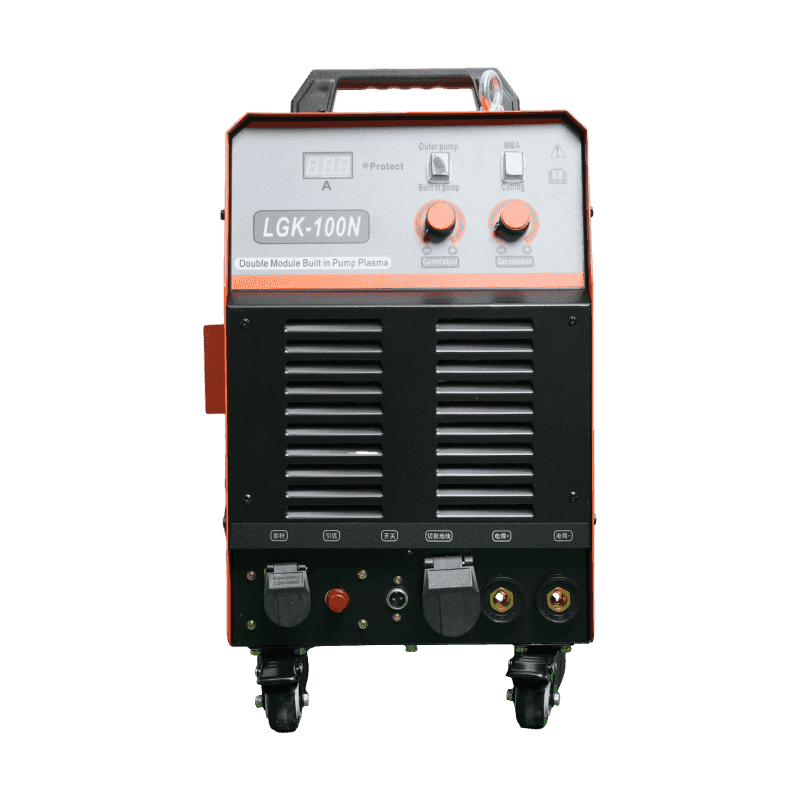NBC-315S/NBC-350S 380V 350A IGBT Inverter Portable welder 2T/4T MIG/MAG/MMA(GMAW/SMAW)
Cat:Gas shielded welding machine
1、The welding machine is small and can be connected to a wire feeder. ...
See DetailsWhen choosing a plasma cutting and welding machine, precision and quality are critical factors that influence the final output of your work. Here’s a breakdown of the requirements you should consider:
The kerf refers to the width of the cut made by the plasma cutter. A machine with a narrow kerf width offers higher precision, minimizing material loss and ensuring tighter tolerances.
The accuracy with which the machine follows the programmed cutting path is crucial. High-precision machines should be capable of maintaining accuracy within a fraction of a millimeter, especially important for intricate designs or parts that require tight fits.
If you're cutting multiple pieces of the same design, the machine should consistently reproduce identical cuts with minimal deviation. High-end machines often boast repeatability within 0.1 mm or better.The quality of the cut edge is a key indicator of precision. A good plasma cutter produces smooth, clean edges with minimal slag (molten metal residue) or dross. Rough or uneven edges may require additional finishing, which reduces overall efficiency.
The initial pierce when cutting can leave a mark or dimple. Precision in piercing is important to avoid distortion or damage, especially on thinner materials or complex geometries.
Precision welding requires fine control over the heat input to prevent warping or distortion, especially on thinner materials. Machines with adjustable heat settings and fine-tuned controls help achieve high-quality welds.
A stable arc is essential for precision welding, ensuring consistent penetration and bead formation. Machines with advanced arc control features produce more consistent welds.
The appearance of the weld bead is an important quality metric. A precise weld will have a smooth, uniform bead without excessive spatter or undercutting. This not only affects the aesthetics but also the structural integrity of the weld.Precision welding requires the ability to control penetration depth to ensure the weld is strong without excessive melt-through. This is particularly critical in applications requiring structural integrity.
For thicker materials requiring multiple passes, the machine should maintain consistency in each pass to avoid defects such as incomplete fusion or porosity.

The design and quality of the plasma torch and welding gun, along with the consumables (like electrodes, nozzles, and tips), greatly affect precision. High-quality consumables reduce wear and improve the accuracy of cuts and welds.For CNC plasma cutting, the precision of the machine’s motion system (e.g., linear guides, motors, and controllers) directly impacts cutting accuracy. Machines with advanced motion control systems offer better precision, especially for complex or high-speed cuts.
In plasma cutting, the consistency and purity of the gas flow affect the cut quality. Machines with precise gas flow control ensure better cut quality and consistency. In welding, shielding gas control is crucial for preventing contamination and achieving clean welds.The software used for CNC plasma cutting should offer precise control over cutting parameters and paths. For welding, software that allows for custom welding programs and sequences can enhance precision.
Proper support and fixturing of the workpiece are necessary to maintain precision during cutting and welding. Any movement or vibration can reduce accuracy and quality.
Depending on the application, the machine should meet the required dimensional tolerances, which specify the allowable deviation from the desired measurements. Tighter tolerances are often needed in industries like aerospace, automotive, and metal fabrication.
The surface finish of the cut or welded area should meet the project’s quality requirements, often dictated by the industry or application. A smoother finish reduces the need for additional processing.The machine should produce cuts and welds with minimal defects, such as cracks, porosity, or inclusions. High-quality machines typically have lower defect rates, contributing to better overall product quality.
Ensure that the machine can produce work that meets relevant industry standards (e.g., ISO, AWS, ASME). Compliance with these standards is often necessary for specific industries or applications.
Regular calibration is necessary to maintain precision and quality. Machines with easy calibration procedures or automated calibration features are preferable.For critical applications, testing methods like non-destructive testing (NDT) for welds or precision measurement tools for cuts may be required to ensure the machine meets the desired quality standards.
By focusing on these aspects of precision and quality, you can select a plasma cutting and welding machine that delivers high-quality results, consistent performance, and meets the specific requirements of your projects.
Contact Us